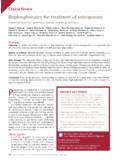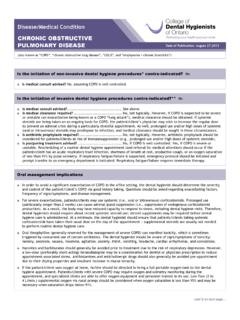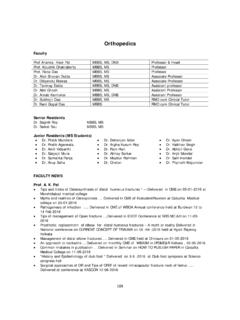Transcription of LCD KYPHOPLASTY Contractor Information LCD Information
1 LCD KYPHOPLASTY Contractor Information Contractor Name First Coast Service Options, Inc. Contract Number 09102 Contract Type MAC - Part B LCD Information LCD ID L29209 LCD Title Vertebroplasty, Vertebral Augmentation; Percutaneous AMA CPT / ADA CDT Copyright Statement CPT only copyright 2002 - 2013 American Medical Association. All Rights Reserved. CPT is a registered trademark of the American Medical Association. Applicable FARS/DFARS Apply to Government Use. Fee schedules, relative value units, conversion factors and/or related components are not assigned by the AMA, are not part of CPT, and the AMA is not recommending their use. The AMA does not directly or indirectly practice medicine or dispense medical services. The AMA assumes no liability for data contained or not contained herein. The Code on Dental Procedures and Nomenclature (Code) is published in Current Dental Terminology (CDT). Copyright American Dental Association.
2 All rights reserved. CDT and CDT-2010 are trademarks of the American Dental Association. Jurisdiction Florida Original Effective Date 02/02/2009 Revision Effective Date 03/31/2014 Revision Ending Date N/A Retirement Date N/A Notice Period Start Date 02/14/2014 Notice Period End Date 03/31/2014 CMS National Coverage Policy Language quoted from CMS National Coverage Determinations (NCDs) and coverage provisions in interpretive manuals are italicized throughout the Local Coverage Determination (LCD). NCDs and coverage provisions in interpretive manuals are not subject to the LCD Review Process (42 CFR [b] and 42 CFR 426 [Subpart D]). In addition, an administrative law judge may not review an NCD. See 1869(f)(1)(A)(i) of the Social Security Act. Unless otherwise specified, italicized text represents quotation from one or more of the following CMS sources: N/A Coverage Guidance Coverage Indications, Limitations, and/or Medical Necessity Indications Percutaneous Vertebroplasty Percutaneous vertebroplasty is a therapeutic, interventional neurosurgical and radiological procedure that consists of the percutaneous injection of a biomaterial, methyl methacrylate, into a lesion of a thoracic or lumbar vertebral body.
3 The procedure is utilized for pain relief and bone strengthening of weakened vertebral bodies. The procedure is performed under fluoroscopic guidance, although some prefer the use of computed tomography (CT) with fluoroscopy for needle positioning and injection assessment. An intraosseous venogram is sometimes performed before cement injection to determine whether the needle is positioned within a direct venous anastomosis to the central or epidural veins, to minimize extravasation into venous structures. Conscious sedation with additional local anesthesia (1% lidocaine) is generally utilized; however, patients who experience difficulties with ventilation or are unable to tolerate prone position during the procedure may require general anesthesia or deep sedation with airway and ventilation support. The methyl methacrylate is injected into the vertebral body until resistance is met or until cement reaches the posterior wall. The procedure usually lasts from 1 to 2 hours, unless cement is injected into two or more vertebral bodies.
4 Percutaneous vertebroplasty procedure will be considered medically reasonable and necessary for the following indications: Painful osteolytic vertebral body metastatic disease; Painful multiple myeloma involving the vertebral body; Painful and/or aggressive hemangioma; or Painful, debilitating, osteoporotic vertebral collapse/compression fractures that have not responded to non-surgical medical management. ( , weeks to months of conservative management ( narcotic and/or non-narcotic medication, physical therapy modalities) with and without methods of immobility ( rest, bracing)), or in the rare exception to weeks to months of non-surgical medical management see Limitation of Coverage Percutaneous Vertebral Augmentation Percutaneous vertebral augmentation (vertebral augmentation) is a minimally invasive procedure for the treatment of compression fractures of the vertebral body. The procedure includes a cavity creation which results in fracture reduction along with an attempt to restore vertebral body height and alignment.
5 Using image guidance x-rays, incisions are made and a probe is placed into the vertebral space where the fracture is located. The collapsed vertebral body is drilled and a device which displaces, removes or compacts the compressed area of the vertebrae is used to create a cavity prior to injection of bone filler (polymethylmethacrylate) (PMMA). Vertebral augmentation procedure will be considered medically reasonable and necessary for the following indications: Painful osteolytic vertebral body metastatic disease; Painful multiple myeloma involving the vertebral body; or Painful, debilitating osteoporotic vertebral collapse/compression fractures that have not responded to non-surgical medical management. ( , weeks to months of conservative management ( narcotic and/or non-narcotic medication, physical therapy modalities) with and without methods of immobility ( rest, bracing)), or in the rare exception to weeks to months of non-surgical medical management see Limitation of Coverage".
6 The decision to perform these procedures should take into consideration the following factors: the local and general extent of the disease, the spinal level involved, the severity of pain experienced by the patient, previous treatments and their outcomes, as well as the patient s neurological condition, general state of health, and life expectancy. It is expected that only those skilled in this procedure/technique will perform it. Rapid access to emergency equipment and personnel is required for both percutaneous vertebroplasty and percutaneous vertebral augmentation. Limitations of Coverage Percutaneous vertebroplasty and percutaneous vertebral augmentation are not to be considered prophylactic for osteoporosis of the spine or for chronic back pain of long-standing duration, even if associated with old compression fractures. In the rare exceptions to providing weeks to months of non-surgical medical management, the documentation must support that one or more vertebral compression fractures are present (confirmed by MRI or CT/bone scan if MRI is contraindicated) and that the patient s pain is predominantly, if not solely, related to the demonstrated fracture(s).
7 Complete assessment of the patient by the physician who performs the procedure is an absolute requirement. The History and Physical exam must be present in the medical record prior to performance of the procedure. The documentation must support the patient has severe debilitating pain unresponsive to adequate pain control and the rationale of proceeding to treatment within a brief period of time after the vertebral fracture has occurred. The medical record must document that appropriate imaging has been performed preoperatively and that the findings of the imaging performed correlate unequivocally with the patient s pain. Absolute Contraindications for both Percutaneous Vertebroplasty and Percutaneous Vertebral Augmentation Absence of confirmed acute or subacute fracture; Symptoms that cannot be related to a fracture; Radicular symptoms that are explained by bone impinging on nerves or another anatomic lesion; Unstable fracture; Asymptomatic vertebral compression fracture; Spinal canal compromise secondary to tumor resulting in myelopathy; Active osteomyelitis, whether fungal bacterial or mycobacterial; Symptomatic spinal stenosis with cauda equine symptoms or signs of cord compression; Uncorrected coagulation disorders; and Known allergy to any material used in the procedure ( PMMA) Absolute contraindications for Vertebral Augmentation Compression fractures without radiographic evidence of edema shown by medical record to be more than one year old.
8 Retropulsed fracture fragment(s) or tumor mass causing significant spinal canal compromise ( long tract or neurological symptom); and When it is technically not feasible ( , vertebra plana). Relative Contraindications to Percutaneous Vertebroplasty significant vertebral collapse ( , vertebra reduced to less than one-third its original height); and extensive vertebral destruction Sacroplasty (0200T, 0201T and 22899) performed for sacral insufficiency fractures due to osteoporosis or other conditions have been suggested as an extension of thoracic/lumbar procedures. The peer reviewed literature is incomplete. Sacroplasty is not the subject of this LCD. This coverage decision is limited to lesions of a thoracic or lumbar vertebral body. Therefore, claims for this procedure will continue to be evaluated on a case by case basis. Coding Information Bill Type Codes Contractors may specify Bill Types to help providers identify those Bill Types typically used to report this service.
9 Absence of a Bill Type does not guarantee that the policy does not apply to that Bill Type. Complete absence of all Bill Types indicates that coverage is not influenced by Bill Type and the policy should be assumed to apply equally to all claims. Revenue Codes Contractors may specify Revenue Codes to help providers identify those Revenue Codes typically used to report this service. In most instances Revenue Codes are purely advisory; unless specified in the policy services reported under other Revenue Codes are equally subject to this coverage determination. Complete absence of all Revenue Codes indicates that coverage is not influenced by Revenue Code and the policy should be assumed to apply equally to all Revenue Codes. 99999 Not Applicable CPT/HCPCS Codes Group 1 Paragraph Group 1 Codes 22520 PERCUTANEOUS VERTEBROPLASTY (BONE BIOPSY INCLUDED WHEN PERFORMED), 1 VERTEBRAL BODY, UNILATERAL OR BILATERAL INJECTION; THORACIC 22521 PERCUTANEOUS VERTEBROPLASTY (BONE BIOPSY INCLUDED WHEN PERFORMED), 1 VERTEBRAL BODY, UNILATERAL OR BILATERAL INJECTION; LUMBAR 22522 PERCUTANEOUS VERTEBROPLASTY (BONE BIOPSY INCLUDED WHEN PERFORMED), 1 VERTEBRAL BODY, UNILATERAL OR BILATERAL INJECTION; EACH ADDITIONAL THORACIC OR LUMBAR VERTEBRAL BODY (LIST SEPARATELY IN ADDITION TO CODE FOR PRIMARY PROCEDURE) 22523 PERCUTANEOUS VERTEBRAL AUGMENTATION, INCLUDING CAVITY CREATION (FRACTURE REDUCTION AND BONE BIOPSY INCLUDED WHEN PERFORMED) USING MECHANICAL DEVICE, 1 VERTEBRAL BODY, UNILATERAL OR BILATERAL CANNULATION (EG, KYPHOPLASTY ).
10 THORACIC 22524 PERCUTANEOUS VERTEBRAL AUGMENTATION, INCLUDING CAVITY CREATION (FRACTURE REDUCTION AND BONE BIOPSY INCLUDED WHEN PERFORMED) USING MECHANICAL DEVICE, 1 VERTEBRAL BODY, UNILATERAL OR BILATERAL CANNULATION (EG, KYPHOPLASTY ); LUMBAR 22525 PERCUTANEOUS VERTEBRAL AUGMENTATION, INCLUDING CAVITY CREATION (FRACTURE REDUCTION AND BONE BIOPSY INCLUDED WHEN PERFORMED) USING MECHANICAL DEVICE, 1 VERTEBRAL BODY, UNILATERAL OR BILATERAL CANNULATION (EG, KYPHOPLASTY ); EACH ADDITIONAL THORACIC OR LUMBAR VERTEBRAL BODY (LIST SEPARATELY IN ADDITION TO CODE FOR PRIMARY PROCEDURE) 72291 RADIOLOGICAL SUPERVISION AND INTERPRETATION, PERCUTANEOUS VERTEBROPLASTY, VERTEBRAL AUGMENTATION, OR SACRAL AUGMENTATION (SACROPLASTY), INCLUDING CAVITY CREATION, PER VERTEBRAL BODY OR SACRUM; UNDER FLUOROSCOPIC GUIDANCE 72292 RADIOLOGICAL SUPERVISION AND INTERPRETATION, PERCUTANEOUS VERTEBROPLASTY, VERTEBRAL AUGMENTATION, OR SACRAL AUGMENTATION (SACROPLASTY), INCLUDING CAVITY CREATION, PER VERTEBRAL BODY OR SACRUM.







